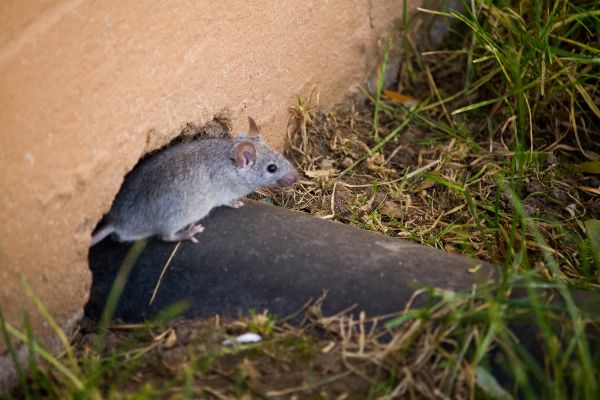How to Tell If You Have Mice or Rats
Rodents like mice and rats can cause serious problems in homes and businesses. Knowing how to identify them is the first step toward effectively resolving a rodent infestation. Read on to learn how to distinguish between mice and rats, recognize the signs of an infestation, and understand how to take control of the problem.

Differences Between Mice and Rats
While mice and rats share similarities,with their ever-growing incisors, long hairless tails, and scavenging habits. They may have very similar traits, but it’s still imperative to understand how to tell the difference between a mouse and rat.
Size and Appearance
Mice are smaller. Adult mice typically grow to about 2.5 to 4 inches in length, not including their long, thin tails. They have large ears, pointed snouts, and soft fur. Mice typically have larger ears and tails compared to their body size.
Rats, on the other hand, are larger and bulkier. Rats typically have larger bodies that are about 6–9 inches in length. They have small, hairy ears and larger feet. Norway rats, for instance, can grow up to 9 inches long with scaly, thick tails. Roof rats are slimmer and more agile, with tails that are longer than their bodies. Rats often appear more menacing due to their blunt noses and coarse fur.
Behavior
Mice tend to be curious and will explore new areas, while rats are more cautious. Rats are also more likely to burrow or climb into areas like the attic and drywall to create nests. Both are nocturnal and active when your home is quiet, often producing scratching or scampering sounds as they move around.
As part of the rodent family, most species of rats and mice are very similar. The main characteristic that all rodents share is their enlarged incisor teeth, which never stop growing. This causes them to chew nonstop, whether it’s furniture, wires, or food sources. Find out more about whether mice are dangerous.
Droppings and Tracks
One of the clearest signs of rodents is their droppings. Mouse droppings have pointed/tapered ends and are just 1–2 mm long. Rat droppings are much bigger, measuring 10–20 mm long. Spotting rodent droppings near food sources, along baseboards, or in cabinets can indicate their presence.
You might also notice tracks like tiny footprints or gnawed marks on furniture, wires, or walls.
Nesting Habits
Mice often nest close to foodstuff, using shredded paper, fabric, or insulation. Rats, particularly Norway rats, prefer to burrow into the ground, while Roof rats create nests in elevated locations such as attics or trees.
Both rats and mice produce several litters annually, but mice are more prolific. Mice produce 5–10 litters a year with up to 14 mice per litter, while rats produce 3–6 litters a year with up to 10 pups in each litter.
Do You Have a Rodent Problem? We Can Help.
Click the button below to leave your information & we'll be in touch in an hour or less.
Pest Control Experts You Can Trust
Leave your information below and we’ll be in touch with your FREE quote!
"*" indicates required fields
*During normal business hours. After hours inquiries will be returned the next business day.
Signs of a Rodent Infestation
Recognizing the early signs of a rodent infestation can prevent it from worsening. Here are common indicators:
Scratching Noises
Rodents are nocturnal and tend to be most active at night. As they move, you may hear scratching, squeaking, or scampering in the walls, ceilings, or floors.
Chewed Wires
Mice and rats have strong teeth that grow continuously, so they constantly chew to keep them filed. This behavior can damage electrical wiring, increasing the risk of fires.
Grease Marks
Rats often leave greasy smudges along walls, baseboards, and entry points due to the oil on their fur. These marks can indicate well-traveled paths.
Mice vs. Rats: Diet Differences
Mice are more likely to nibble on grains, seeds, and crumbs left behind. Mice are omnivores but mostly feed on seeds, grains, and fruits. Rats, on the other hand, have a more diverse diet. Rats are opportunistic scavengers that will eat meats, grains, seeds, and much more. Both rodents can contaminate foodstuff with urine, droppings, and saliva, spreading diseases like Hantavirus and leptospirosis.
Which Infestation Is Worse?
While it’s important to know what type of rodent problem you have, the truth is that an infestation of rats or mice can be dangerous. Both rats and mice alike can carry and spread a number of potentially dangerous diseases. They can also trigger allergies in people. Rats are generally more destructive due to their size and chewing capabilities. They can gnaw through drywall, wood, and even metal. A rodent problem can be a mess to clean up due to the amount of droppings and urine left behind. Lastly, they can cause significant damage to your home.
Do You Have a Rodent Problem? We Can Help.
Click the button below to leave your information & we'll be in touch in an hour or less.
Pest Control Experts You Can Trust
Leave your information below and we’ll be in touch with your FREE quote!
"*" indicates required fields
*During normal business hours. After hours inquiries will be returned the next business day.
Identifying and Controlling Rodents
Understanding how to detect and prevent rodent infestations can minimize damage and reduce the health risks associated with these pests.
Detection Tools
Identifying rodent activity starts with the right tools and observations. Motion-activated cameras or traps can help you monitor their movements and locate problem areas. Look for key signs of infestation, such as droppings, gnawed furniture or wires, and nests made from shredded materials.
These indicators can help you pinpoint where rodents are active in your home or business. For additional assistance, refer to our comprehensive rodent identification guides.
Prevention Tips
Preventing a rodent problem begins with taking proactive measures to make your space less inviting. Start by sealing any cracks and holes in walls, baseboards, and foundations to eliminate entry points. Store food items in airtight containers to keep them out of reach, and clean up crumbs and spills promptly.
To discourage roof rats, trim trees and bushes near your home to reduce access points. Eliminating water sources like leaking pipes or standing water is equally essential, as rodents are attracted to moisture.
Need help with commercial pest control?
Our experts can identify whether you’re dealing with Norway rats, Roof rats, or house mice and provide tailored solutions. Whether it’s removing rodent droppings, addressing structural damage, or implementing prevention plans, we’ve got you covered.
Contact us today for a free estimate and regain control of your space.
To learn more about mice and rats read more in our articles below:
Do You Have a Rodent Problem? We Can Help.
Click the button below to leave your information & we'll be in touch in an hour or less.
Pest Control Experts You Can Trust
Leave your information below and we’ll be in touch with your FREE quote!
"*" indicates required fields
*During normal business hours. After hours inquiries will be returned the next business day.
